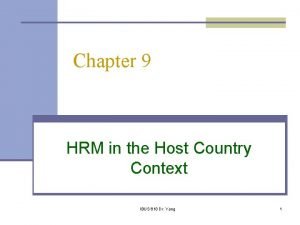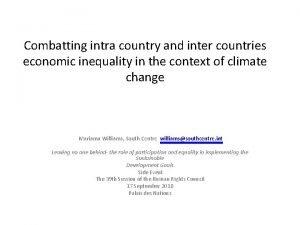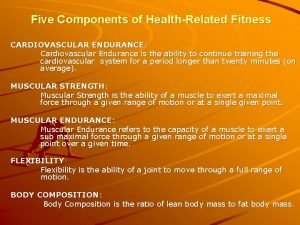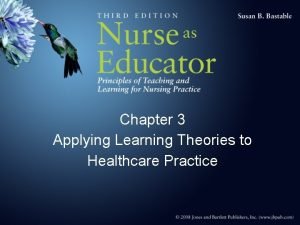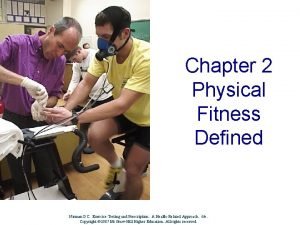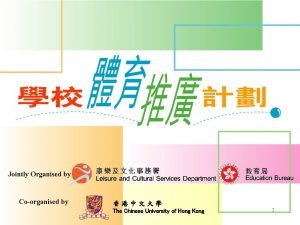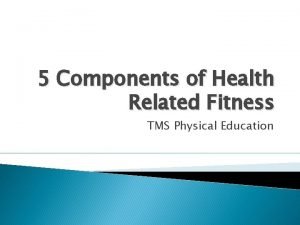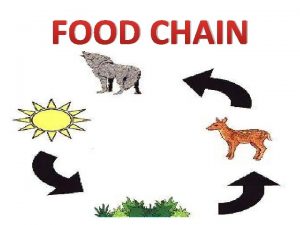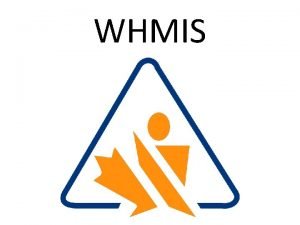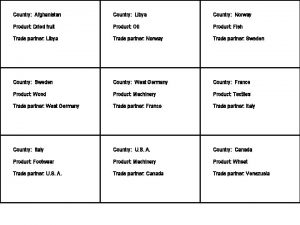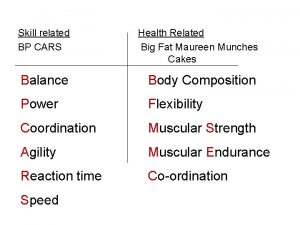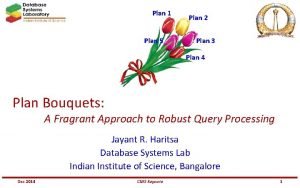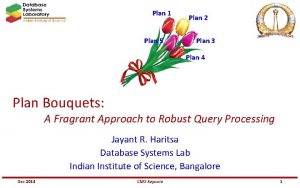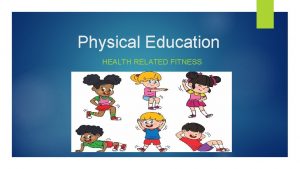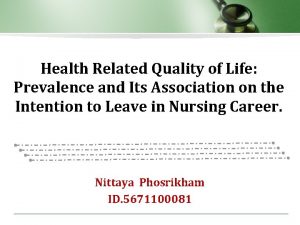How does a country plan its health related




































- Slides: 36

How does a country plan its health related activities? ?

Health Committees

Health Planning in India Guidelines: many Committees Appointed by GOI: review existing health situation, recommend measures Planning Commission NITI Aayog

Health Committees 1. Bhore committee 2. Mudaliar committee 3. Chadah committee 4. Mukerji committee 5. Jungalwala committee 6. Kartar Singh committee 7. Shrivastav committee 8. Rural Health Scheme

Sir Joseph Bhore

Bhore Committee, 1946 In 1943: Health Survey and Development Committee Met regularly for 2 years: submitted report in 1946. To build nation’s health: Focus on health programs and preventive aspects

Recommendations Integration of preventive +curative services at all administrative levels Development of Primary Health Centres: ü Short term : 40, 000 populaation ü Long term: 75 bedded hospital-10 to 20, 000 population 3 months training: Preventive and Social Medicine- “Social Physicians”.

AL Mudaliar

Mudaliar Committee, 1962 In 1959: Health Survey and Planning Committee to survey the progress made since submission of Bhore committee report Observations: Quality of services : PHCs inadequate Recommended the strengthening of existing PHCs, sub-divisional and district hospitals

Recommendations Strengthen District Hospitals: specialists Each PHC not more than 40, 000 Improve quality of services in PHC Integrate medical and health services

Chadah Committee, 1963 In 1963, appointed: Dr. MS Chadah- DGHS: study National Malaria Eradication Programme Monthly home visits: Basic health workers One per 10, 000 As Multipurpose worker: family planning, malaria. Family Planning Health Assistants: supervise 3 -4 health workers.

Mukerji Committee, 1965 Realized: basic health workers- not function effectively as multipurpose workers So, malaria operations suffered Work of family planning programme suffered Committee 1965: set up Separate staff: family planning only Delink malaria from family planning

Mukerji Committee, 1966 States: difficulty- burden of Health Programmes Paucity of funds Basic Health Service : PHC level

Jungalwalla Committee, 1967 Committee on integration of health services Defined integrated health services: ü Service : unified approach for all problems ü Medical care for sick, health programmes : unified manner

Jungalwalla Committee, 1967 Main steps: ü Unified cadre ü Recognize extra qualifications ü Equal pay for equal work ü Special pay for specialized work

Kartar Singh Committee, 1973. Committee on Multipurpose Workers under Health and Family Planning Objectives: Structure of integrated services Feasibility: multipurpose workers and training

Recommendations Auxillary Nurse Midwives: Female Health Workers Multipurpose workers: areas- malaria is in maintenance phase, smallpox controlled One PHC: 50, 000

Recommendations Each PHC: 16 sub-centres (3, 000 -5, 000) Each sub-centre: male, female health workers Male Health Supervisor: 3 -4 male health workers Doctor in PHC : overall charge of supervisors

Shrivastav Committee, 1975 Group on Medical Education and Support Manpower Objectives: Curriculum of training of health assistants: Bridge Suggest steps: improve existing medical education

Recommendations Create para-professional and semi-professional health workers from community (school teachers, postmasters) Establish 2 cadres of health workers: ü Multipurpose health workers ü Health assistants Develop referral linkages Establish Medical and Health education Commission

Rural health scheme, 1977 Recommendations: ü Involve Medical Colleges in total health care of PHCs ü Train multipurpose workers on communicable diseases

Health for all , 2000 Working group on health constituted by Planning Commission -1980 Identified the approach to achieve : Health For All, 2000

Summary Bhore Mudaliar Chadah Mukerjee Jungalwala Kartar Singh Srivastava

Summary Bhore Committee: Primary Health Centres Mudaliar: Strengthening of exixting services, integrate medical + health care Chadah: malaria, multi purpose health workers Mukerjee: separate malaria, family planning Jungalwala: Unified approach, integrate health services Kartar Singh: MHW, FHW, HA Srivastava: medical education, health workers

International Organizations

1. Enumerate any 5 international health organisations 2. Name the organisations in field of: i. Occupational health ii. Offers loans iii. Family planning iv. GOBI FFF

Other organizations UNDP (United Nations Development Program) Main source of funds for technical assistance UNFPA (United Nations Fund for population Activities) Providing assistance to India since 1974 FAO (Food and Agricultural Organization) Objective: Help poorer nations to develop their human and natural resources Development of health and family welfare services, infrastructure and improvement in availability of services in rural areas Objectives: To help the nations to raise their living standards Increase efficiency of farming, forestry and fisheries Covers health, education, science, industry and agriculture sectors To develop national capability in manufacture of contraceptives, develop population education programs, improve services approach (innovative approach) Prime concern: Increased production of food and combat malnutrition Formed in 1945 with headquarters in Rome

ILO (International Labour Organization) To improve through international action the working, living conditions and labour conditions of all workers World Bank Established with the purpose of helping less developed nations to raise their living standards Bank offers loans for projects whish will lead to economic growth Works in close collaboration with Projects concerned with electric WHO in field of health and labour power, roads , railways, agriculture, water supply, education, family planning Headquarters: Geneva, Collaborative projects with WHO Switzerland include: water supply projects, World Food programme, Population control

International Agencies Rockefeller Foundation Ford Foundation CARE ( Cooperative for Assistance & Relief Everywhere) International Red Cross

Rockefeller Foundation Philanthropic organization Mr. John. D. Rockefeller Chartered in 1913 Promote the well being of mankind throughout the world Mainly public health and medical education Expanded over to life sciences, social sciences, humanities, agriculture and family planning Initiated work in 1920 with a scheme for control of hookworm disease in Madras

Ø All India Institute of Hygiene and Public Health in Calcutta Ø Providing grants in aid to selected institutions Ø Development of medical college libraries Ø Assistance to research projects and institutions Ø Ballabgarh field demonstration center Ø National institute of virology in Pune

Ford Foundation Rural health services and family planning FORD foundation helped India in the following projects: Research cum action projects - Aimed at solving basic problems in environmental sanitation, ex. Designing and construction of hand flushed sanitary latrines in rural areas Pilot projects in rural health services Establishment of NIHAE in New Delhi: Training for health administrators Calcutta water supply and drainage scheme Family planning fellowship programme

CARE – Cooperative for Assistance and Relief Everywhere Founded in North America Worlds largest, independent, non profit, international relief and development organization Initiated its operation in India in 1950 Works in partnership with Government of India CARE provides emergency aid and long term development assistance

Provide food for children 6 -11 years Food support in ICDS Child survival project Integrated nutrition and health project Anemia control project Improving women’s health project Improved health care for adolescent girls project Improving women’s reproductive health and family spacing project

International Red Cross Henry Dunant, Swiss Businessmen Devoted to service of mankind in peace and war Proposed the idea of establishment of national societies which would render aid to the wounded without distinction of nationality International Committee of the Red Cross (ICRC), an independent neutral institution Role of Red Cross: Village upliftment First aid Anti epidemic work International friendliness

Review Role of International NGOs: i. All India Institute of Hygiene and Public Health in Calcutta, Ballabgarh, NIV Pune ii. NIHAE iii. Supports nutrition projects iv. Family planning projects: v. Educational projects vi. Women and child health vii. Rural service viii. Environmental sanitation
 Skill related fitness vs health related fitness
Skill related fitness vs health related fitness National programmes related to child health and welfare ppt
National programmes related to child health and welfare ppt Two types of fitness
Two types of fitness Host country and home country
Host country and home country Intra country vs inter country
Intra country vs inter country This music is featured during sabbath and other holy days
This music is featured during sabbath and other holy days Every country has their own traditions
Every country has their own traditions Every country has its
Every country has its Every nation and every country has its
Every nation and every country has its National policies related to child health and welfare
National policies related to child health and welfare Components of health related fitness
Components of health related fitness Fitness components
Fitness components Clinical judgement sample items a ati
Clinical judgement sample items a ati What is the average time for hexagon agility test
What is the average time for hexagon agility test Learning theories related to health care practice
Learning theories related to health care practice Physical fitness and its components
Physical fitness and its components Health related physical fitness definition
Health related physical fitness definition Health related fitness
Health related fitness Skill related components
Skill related components Components of health related fitness
Components of health related fitness Five components of health related fitness
Five components of health related fitness 6 components of health related fitness
6 components of health related fitness Emigree poem summary
Emigree poem summary When a train increases its velocity its momentum
When a train increases its velocity its momentum Sunny windy rainy cloudy
Sunny windy rainy cloudy If its square its a sonnet
If its square its a sonnet Its halloween its halloween the moon is full and bright
Its halloween its halloween the moon is full and bright Its not easy but its worth it
Its not easy but its worth it Which country does not use the metric system
Which country does not use the metric system Phrase or clause examples
Phrase or clause examples How does threegreen classify its assets?
How does threegreen classify its assets? Does salt lose its flavor
Does salt lose its flavor Lion
Lion Silkworm shedding skin
Silkworm shedding skin Does the needle ever wink its eye
Does the needle ever wink its eye Whims stands for
Whims stands for Roles of occupational health nurse
Roles of occupational health nurse



